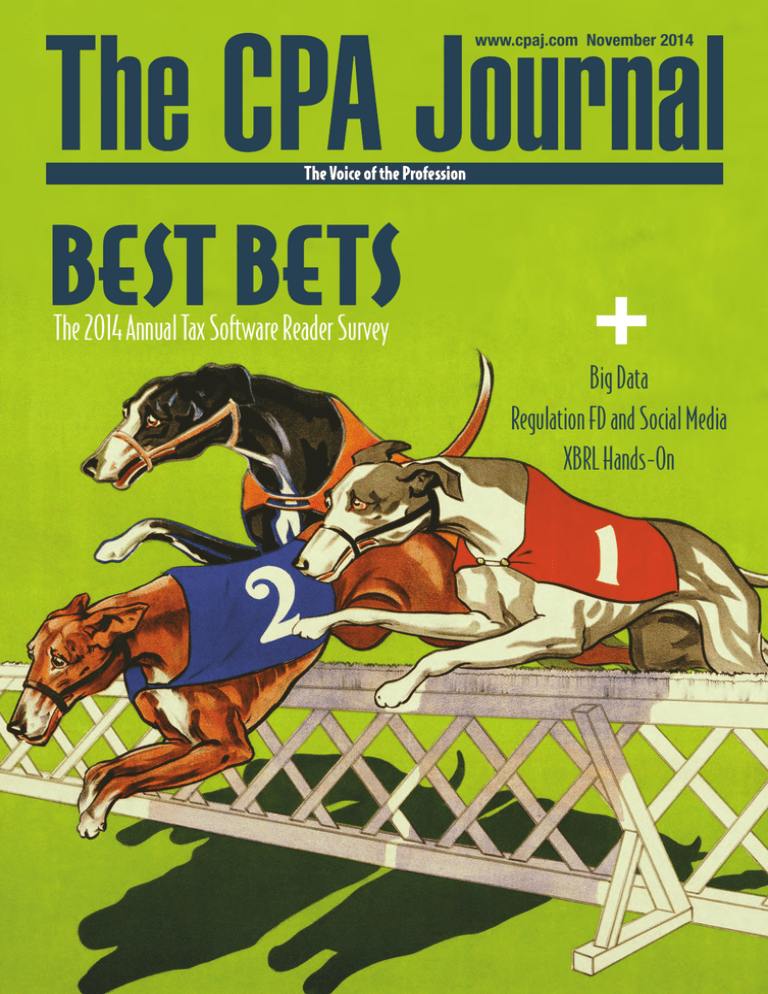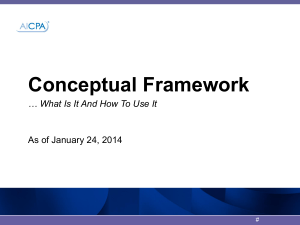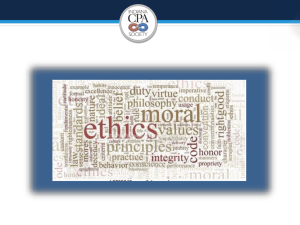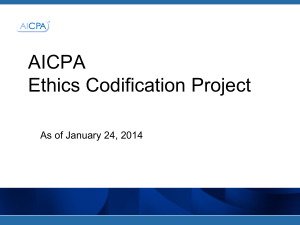+ BEST BETS The 2014 Annual Tax Software Reader Survey Big Data
advertisement

www.cpaj.com November 2014 The Voice of the Profession BEST BETS The 2014 Annual Tax Software Reader Survey + Big Data Regulation FD and Social Media XBRL Hands-On R E S P O N S I B I L I T I E S ethics & L E A D E R S H I P Twenty Questions about the AICPA’s New Ethics Codification Expanded Conceptual Approach for Professionals in All Forms of Practice By Heidi Tribunella and Thomas Tribunella T he NYSSCPA adopted the AICPA’s Code of Professional Conduct as its own code on May 16, 2013. Given the recent updates to the AICPA’s code, CPAs should reacquaint themselves with the new provisions. These changes will enable CPAs to utilize technology to access and interact with the Code of Professional Conduct; this will, in turn, help them become more efficient and effective. 1. What Is the AICPA’s Ethics Codification Project? The codification project involved a general restructuring of the AICPA’s Code of Professional Conduct. The restructuring organized it by sections applicable to all members, to members in public practice, to members in business, and to other members. The Internet-based Code of Professional Conduct provides tools for members to search for the section applicable to them and their particular situation. In addition, it enables users to create bookmarks and to e-mail links to relevant sections. It also includes pop-up definitions for certain terms and hyperlinks to connect relevant portions together. 2. Why Did the AICPA Undertake the Project? The AICPA’s Ethics Codification Project aims to make it easier and more intuitive for members to use the Code of Professional Conduct. By utilizing technology, the AICPA made it more userfriendly and efficient. In addition, the online format makes it more accessible, with updates instantly available. however, the conceptual frameworks and related interpretations will be effective December 15, 2015. Early implementation is permitted. 4. Where Is the New Code Available? The new online Code of Professional Conduct is accessible from http://pub. aicpa.org/codeofconduct/Ethics.aspx. Users can also download the entire code as a pdf at http://www.aicpa.org/Research/ Standards/codeofconduct/Pages/default.aspx. 5. Are Previous Versions Still Available? The current Code of Professional Conduct, in effect until December 15, 2014, can be found at http://www.aicpa. org/Research/Standards/codeofconduct/ Pages/default.aspx. Also available here are previous versions dating back to June 1, 2008. 6. Are Transition Resources Available? 3. When Is the New Code Effective? The new AICPA Code of Professional Conduct is effective December 15, 2014; 56 The AICPA has created a mapping document—an Excel spreadsheet that shows the numbers, citations, and titles of the old Code of Professional Conduct, as well as where they are located in the new version (available for download at http://www.aicpa.org/InterestAreas/ ProfessionalEthics/Community/Downloadable Documents/Mapping.xlsx). In addition, this mapping document includes a tab that shows which items were deleted prior to the new codification. 7. What Other Features Does the Online Code Have? The online version includes basic searches, advanced searches, e-mail links, bookmarks, and an area to take notes. In addition, within the Code of Professional Conduct itself, pop-up notifications show definitions of terms, and hyperlinks connect relevant portions together. To take notes, users must create an account and complete a free registration by providing their name, an e-mail address, and a password. The advanced search tool allows users to search by all words, any words, an exact phrase, or to use Boolean logic. Users can NOVEMBER 2014 / THE CPA JOURNAL search the entire Code of Professional Conduct or specify a particular part or even a section of the appendix. In addition, users can select whether the search feature provides excerpts and whether the search focuses only on citations containing nonauthoritative guidance. The numbering has been made consistent across the Code of Professional Conduct. For example, the Introduction is always at “000” and Acts Discreditable is always at “400,” whether it applies to members in public practice, business, or other. In addition, numbers are skipped in a particular part if that section is not applicable to those types of members. For example, “200” (for independence) is only used in Part 2: Members in Public Practice; there is no “200” in Members for Business and Other Members because independence is not a requirement for those members. The Code of Professional Conduct is further broken down into subtopics. 8. What Major Changes Were Made? Although most of the ethical guidance remains the same, some language was changed for consistency; now, users will notice similar language throughout the Code of Professional Conduct. The most substantive changes are the two new conceptual frameworks, one for members in public practice and another for members in business. In addition, certain nonauthoritative guidance is now included at the end of applicable topics or sections. 9. How Is the New Code Organized? The new Code of Professional Conduct is organized into the following parts: n Preface: Applicable to All Members n 0.100 Overview of the Code of Professional Conduct n 0.200 Structure and Application of the AICPA Code n 0.300 Principles of Professional Conduct n 0.400 Definition n 0.500 Nonauthoritative Guidance n 0.600 New, Revised, and Pending Interpretations and Other Guidance n 0.700 Deleted Interpretations and Other Guidance n Part 1: Members in Public Practice n 1.000 Introduction n 1.100 Integrity and Objectivity n 1.200 Independence n 1.300 General Standards n 1.400 Acts Discreditable n 1.500 Fees and Other Types of Remuneration n 1.600 Advertising and Other Forms of Solicitation n 1.700 Confidential Information n 1.800 Form of Organization and Name n Part 2: Members in Business n 2.000 Introduction n 2.100 Integrity and Objectivity n 2.300 General Standards n 2.400 Acts Discreditable n Part 3: Other Members n 3.000 Introduction n 3.400 Acts Discreditable NOVEMBER 2014 / THE CPA JOURNAL Accounting and Auditing of Broker/Dealers Technical Sessions JOIN THE STOCK BROKERAGE COMMITTEE FOR THESE POPULAR 3-HOUR TECHNICAL SESSIONS AVAILABLE IN-PERSON AND VIA LIVE VIDEO WEBCAST FAE Learning Center, 14 Wall Street, 19th Floor, New York City Morning Session: Introduction to Broker/Dealers and Reporting Requirements Wednesday, November 19, 2014, 9:00 a.m.–12:00 p.m. CPE Credit: 3 Afternoon Session: Current Regulatory Developments for Your Broker/Dealer Practice Wednesday, November 19, 2014, 1:00 p.m.–4:00 p.m. CPE Credit: 3 Register Today! For more information and to register, visit www.cpe.nysscpa.org or call 800-537-3635. 57 10. What Is the Conceptual Framework Approach? The conceptual framework approach defined in the Code of Professional Conduct relies upon the idea of threats and safeguards. Members should first identify threats. Next, they should evaluate the significance of each threat. Finally, they should identify and apply appropriate safeguards. The following definitions in Code of Professional Conduct section 1.000.010.04-06 are helpful in understanding the conceptual frameworks: n Acceptable level—“A level at which a reasonable and informed third party who is aware of the relevant information would be expected to conclude that a member’s compliance with rules is not compromised” n Safeguards—“Actions or other measures that may eliminate a threat or reduce a threat to an acceptable level” n Threats—“Relationships or circumstances that could compromise a member’s compliance with the rules.” The frameworks apply when there is no specific guidance in the Code of Professional Conduct, but they cannot be used to override existing rules and interpretations. The conceptual frameworks have a later effective date (December 15, 2015), but early implementation is permitted. 11. What Is the New Conceptual Framework for Members in Public Practice? The conceptual framework for members in public practice uses the threats and safeguards approach described in Question 10. Members in public practice must reduce threats to an acceptable level using appropriate safeguards for the situation in order to be in compliance with the Code of Professional Conduct. If threats cannot be reduced to an acceptable level, members should consider the appropriate steps to remove themselves from the situation. Members in public practice must also consider the independence conceptual framework. 12. Which Types of Threats Do Members in Public Practice Face? The types of threats faced by members in public practice include adverse interest, advocacy, familiarity, management participation, self-interest, self-review, and undue influence. Code of Professional Conduct 58 sections 1.000.010.10–.16 define these threats as follows: n Adverse interest threat—“the threat that a member will not act with objectivity because the member’s interests are opposed to the client’s interests” n Advocacy threat—“the threat that a member will promote a client’s interest or position to the point that his or her objectivity or independence is compromised” n Familiarity threat—“the threat that, due to a long or close relationship with a client, a member will become too sympathetic to the client’s interests or too accepting of the client’s work or product” The most substantive changes are the two new conceptual frameworks, one for members in public practice and another for members in business. n Management participation threat—“the threat that a member will take on the role of client management or otherwise assume management responsibilities, such [as] may occur during an engagement to provide nonattest services.” n Self-interest threat—“the threat that a member could benefit, financially or otherwise, from an interest in, or relationship with, a client or persons associated with the client.” n Self-review threat—“the threat that a member will not appropriately evaluate the results of a previous judgment made or service performed or supervised by the member of an individual in the member’s firm and that the member will rely on that service in forming a judgment as part of another service.” n Undue influence threat—“the threat that a member will subordinate his or her judgment to an individual associated with a client or any relevant third party due to that individual’s reputation or expertise, aggres- sive or dominating personality, or attempts to coerce or exercise excessive influence over the member.” 13. Which Safeguards Can Members in Public Practice Use? Safeguards employed by members in public practice are categorized into three major areas: 1) those created by professional standards, legislation, or regulation; 2) those implemented by the client; and 3) those implemented by the firm. Specific examples included in the Code of Professional Conduct that have been created by professional standards, legislation, or regulation include education and training requirements, continuing education requirements, external review of a firm’s quality control system, prohibitions, and competency and experience requirements for licensure. The Code of Professional Conduct also lists examples of client safeguards, such as hiring personnel with appropriate knowledge and background to make managerial decisions regarding professional services, and establishing a tone at the top and policies and procedures that demonstrate a commitment to fair financial reporting and compliance with laws and regulations, as well as policies and procedures, related to ethical conduct. Some examples of firm safeguards include firm leadership that stresses compliance, policies and procedures related to engagement quality control, training, disciplinary mechanisms, rotation of senior personnel on engagement teams, and removal of engagement team members with threats to independence. 14. How Did the Conceptual Framework for Independence Change? The conceptual framework for independence in the new code did not change significantly from the old Code of Professional Conduct; in fact, the new conceptual frameworks mirror the old independence framework. 15. What Is the New Conceptual Framework for Members in Business? This conceptual framework also uses the threats and safeguards approach described in Question 10. Members in business must reduce threats to an acceptable level using appropriate safeguards for the situation in order to comply with the Code of NOVEMBER 2014 / THE CPA JOURNAL Professional Conduct. If threats cannot be reduced to an acceptable level, members should consider the appropriate steps to remove themselves from the situation. 16. Which Types of Threats Do Members in Business Face? Members in business face adverse interest, advocacy, familiarity, self-interest, selfreview, and undue influence threats. The definitions of these threats are similar to those listed in Question 12, except that they relate to the organization employing the member, rather than to the client. 17. Which Safeguards Can Members in Business Use? The AICPA has a website devoted to the codification project, at http://www. aicpa.org/InterestAreas/ProfessionalEthics /Community/Pages/aicpa-ethics-codification-project.aspx. The website includes a helpful video explaining the project, as well as links to articles about the project and the codification. It also features an archived webcast and presentations on the topic. q Heidi Tribunella, CPA, is a clinical associate professor of accounting, Simon Business School, University of Rochester, Rochester, N.Y. Thomas Tribunella, PhD, CPA, is a professor of accounting in the school of business at the State University of New York (SUNY) at Oswego. NYSSCPA Thanks Its Loyalty Media ǼÆ ĄǺÆ ÅĂĀÄÃÂÁÆÀÁÆ ĀĀ ▶ Safeguards used by members in business are separated into two categories: 1) those created by professional standards, legislation, or regulations, and 2) those implemented by the employer. Some examples of the former include education and training on ethics and professional responsibilities, ethics continuing education requirements, professional standards and threats of discipline, and ethics hotlines. Examples of the latter include tone at the top, audit committee charter, and the independence of audit committee members, as well as internal policies and procedures related to internal controls. 20. Where Can One Find More Information? 18. Do Rules and Interpretations Still Apply? Yes, rules are still included in the Code of Professional Conduct, followed by interpretations of those rules. For example, the Integrity and Objectivity Rule for members in business is located at section 2.100.001; the interpretations associated with this rule are codified immediately following and include sections 2.100.005 (Application of the Conceptual Framework), 2.110 (Conflict of Interest), 2.120 (Gifts and Entertainment), 2.130 (Preparation and Reporting of Information), and 2.160 (Educational Services). There is a small section (Part 3) related to members other than those in public practice or in business, such as former professionals who are retired or professionals who are currently not employed. This section only includes an Introduction and Acts Discreditable. NOVEMBER 2014 / THE CPA JOURNAL ▶ 19. Which Part of the Code Is Applicable to Other Members? If you are interested in learning more about NYSSCPA’s Loyalty Media Program, contact Allison Zippert at 410.584.1971 or azippert@networkmediapartners.com. 59




